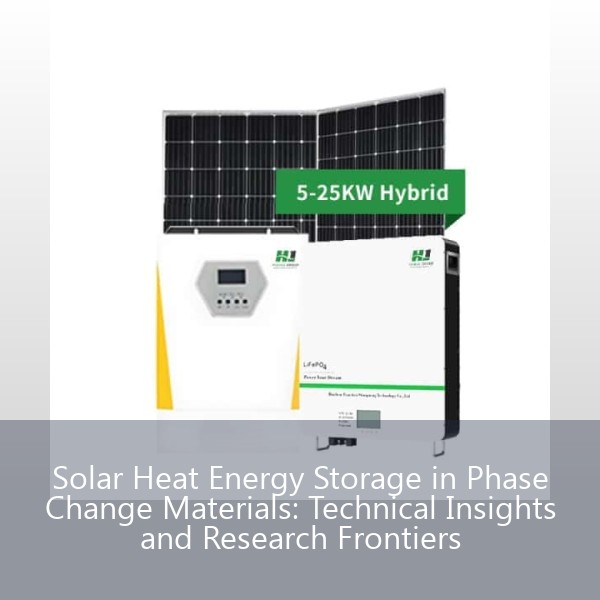Solar Heat Energy Storage in Phase Change Materials: Technical Insights and Research Frontiers

Why Phase Change Materials Are Solar Energy's Best Friend
Imagine sunlight as a hyperactive toddler – full of energy but impossible to manage without a nap schedule. That's where phase change materials (PCMs) come in, acting as the ultimate babysitter for solar thermal energy. These clever substances absorb excess heat like a sponge during peak sunlight hours, then release it on demand when you need warmth the most. Recent studies show PCM-based systems can improve solar thermal efficiency by 40-60% compared to conventional methods.
The PCM Hall of Fame: Materials Making Waves
- Salt Hydrates: The overachievers of thermal storage, with energy densities up to 200 MJ/m³. Calcium chloride hexahydrate can store 4x more heat than concrete per unit volume
- Paraffin Waxes: The reliable workhorses melting between 20-60°C – perfect for residential applications
- Eutectic Mixtures: The chemical equivalent of power couples, like sodium nitrate-potassium nitrate blends that work seamlessly up to 300°C
Real-World Applications That Actually Work
A 2024 field study in Nordic climates demonstrated something remarkable – homes using NH4Al(SO4)2·12H2O PCM panels reduced heating fuel consumption by 68% during polar vortex events. The secret sauce? This inorganic PCM maintains stable phase transitions even at -15°C, acting like a thermal battery for solar collectors.
Engineering Challenges: It's Not All Sunshine
Even the best PCMs have their kryptonite. Paraffins might leak like a sieve without proper encapsulation, while salt hydrates can be more temperamental than a prima donna – 30% experience phase segregation issues over time. Modern solutions include:
- 3D-printed graphene oxide matrices (improves thermal conductivity by 400%)
- Microencapsulation techniques using silica shells (extends cycle life to 10,000+ charges)
The Future Is Multilayered
Researchers are now developing cascading PCM systems that work like a thermal relay race. Imagine three materials working in sequence: Erythritol (120°C) hands off to Sodium acetate trihydrate (58°C), which then passes to Paraffin (27°C). This approach achieved 92% exergy efficiency in recent lab tests – essentially wasting less heat than a Michelin-starred chef wastes ingredients.
Where to Find Cutting-Edge Research
For those hunting PDF resources, prioritize recent studies (post-2020) addressing these key areas:
- Hybrid organic-inorganic composites
- Machine learning optimization of charge/discharge cycles
- Nano-enhanced thermal conductivity solutions
Pro tip: Search academic databases using Boolean terms like "PCM" AND "solar thermal storage" NOT "battery" to filter irrelevant results. The U.S. Department of Energy's OSTI.gov repository remains a goldmine for technical reports, though newer findings often appear in Solar Energy Materials and Solar Cells journal first.
- Pre: Innovations in Ice Pick Thermal Energy Storage Software Solutions
- Next: Glycogen 101: The Animal Kingdom's Energy Savings Account
Related Contents

Harnessing the Sun's Power: How Phase Change Materials Revolutionize Solar Heat Energy Storage
solar panels get all the glory in renewable energy conversations, but what happens when the sun takes a coffee break? This is where solar heat energy storage in phase change materials becomes the unsung hero of sustainable energy systems. Imagine a thermal battery that absorbs excess heat like a sponge and releases it on demand. That's exactly what PCMs do, and they're changing the game for solar applications.

Solar Thermal Energy Storage: How Phase Change Materials Are Revolutionizing Renewable Energy
Ever wondered how ice cream stays frozen in your cooler for hours? That's phase change in action - and scientists are now using this same principle to store solar thermal energy. Phase change materials (PCMs) absorb and release thermal energy during their melting/solidifying processes, making them perfect for solar energy storage systems. Unlike your ice pack, these advanced materials operate at much higher temperatures (typically between 20°C to 150°C) and can store 5-14 times more heat per unit volume than conventional materials.

Phase Change Materials for Solar Energy Storage: The Ultimate Guide
Ever wondered how solar thermal systems keep delivering hot water after sunset? Enter phase change materials (PCMs) - nature's thermal batteries that store solar energy like squirrels hoard acorns. These smart materials absorb heat by changing physical states (solid to liquid or vice versa), releasing stored energy when you need it most.
